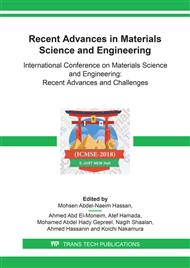p.325
p.335
p.342
p.348
p.356
p.364
p.373
p.384
p.393
In Implementing a Metal 3D AM Machine
Abstract:
Additive Manufacturing (AM) does not yet have a standardized way to measure performance. Here a AM machines dimensional accuracy is measured trough acceptance test (AT) and AM machines capability is tested trough test parts. Test parts are created with specific geometrical features using a 3D AM machine. Performance of the machine is then evaluated trough accuracy of test parts geometry. AM machine here uses selective laser melting (SLM) process. This machine has done Factory acceptance test (FAT) to ascertain this machine ́s geometrical accuracy with material AISI 316L. Manufacturer promises accuracy of ±0.05 mm. These parts are used as comparison to AT parts made in this study. After installation two AT parts are manufactured with AM machine. One with AISI 316L and one AlSi10Mg. Dimensional accuracy of geometrical features on these parts are then compared to FAT part and to one another. Machines capability is measured trough two test parts done with material AlSi10Mg. Two of the test parts are done at the same time using same model as the FAT. Parts are printed without supports and with features facing same directions. Features of these parts were then evaluated. Another test to find out AM machines capability was to create part consisting of pipes doing 90˚ angle resulting in horizontal and vertical holes. Dimensional accuracy and circularity of holes was measured. Through these tests machines capability is benchmarked.
Info:
Periodical:
Pages:
356-363
Citation:
Online since:
October 2018
Authors:
Keywords:
Price:
Сopyright:
© 2018 Trans Tech Publications Ltd. All Rights Reserved
Share:
Citation:


